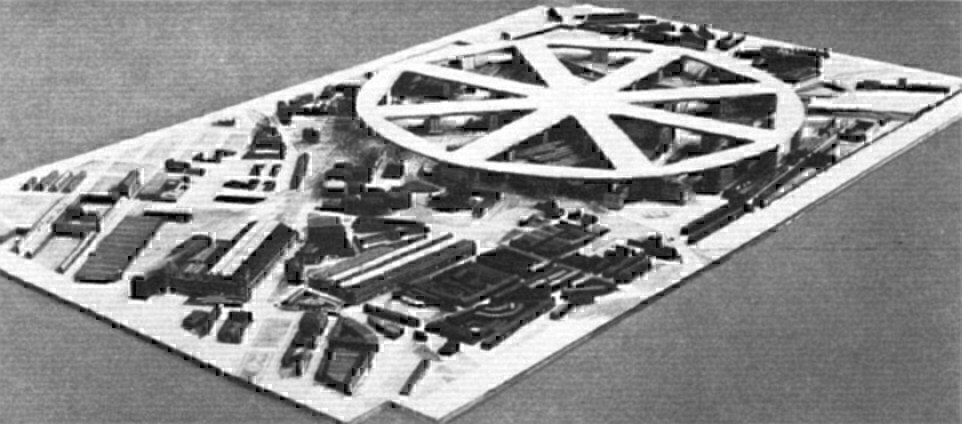Once upon a time, in a faraway land, a designer imagined a new airport for London. The airport would be a Goldilocks among airports; not too big or too small, and conveniently located just steps from the beating heart of the city. Only one problem; the designer was completely off his rocker.The city of London is one of the busiest in the world for air traffic. Each year, more than a million aircraft movements take place in London, with around 150m passengers passing through the airports.Despite having no less than five airports serving the city, slots are still hard to come by and, at least at some airports, are worth their weight in gold. Even so, none of these airports are really ‘in’ London, save for London City which is still a good 40-minute commute to the center and has some serious restrictions on the planes that can land there.But once, a long time ago, someone had an idea for an airport which could have changed all this and placed an airport in the heart of the downtown area. This is the story of Kings Cross Airport.
Kings Cross Airport
In 1931, Kings Cross was one of the most deprived areas of London. It was home to the city’s notorious red-light district and was ripe for investment and regeneration. One architect, Charles Glover, noticed this opportunity and set about designing an airport hub for the city.
Mr. Glover’s concept involved a cartwheel shaped construction which would sit over the top of the railway sidings just north of St Pancras. Each runway would stretch around half a mile, and aircraft would be guided in by the newly named ‘Aerial Way’, otherwise known as Pentonville Road.
The plans would have cost £5m to put into practice, but would likely have received little criticism from locals influencers, as Kings Cross was regarded as a bit of a dump anyway. With no high rise buildings at the time, approaching aircraft would have had a clear passage onto the runway from any angle.
Glover imagined passengers would have been conveyed to the level of the runway via lifts in the buildings below. Aircraft would have been able to take off in eight different directions thanks to the spoke-like design, with a taxi space around the rim of the wheel.
Why didn’t it work?
Despite Glover’s keen enthusiasm for a Kings Cross airport, the idea was fatally flawed. Although at the time, aircraft were small and slow, only requiring short runways for takeoff and landing, pretty much everyone recognized that this probably wouldn’t always be the case.
An aerial runway built on top of supporting buildings has no options for extension later on, so as aircraft grew bigger and faster, the runways would have become redundant. While the lack of tall buildings at the time meant the idea could work, in the long run London would not wish to restrict itself from building upwards at some point in the future.
Added to this is the fact that the design is, well let’s be honest here, completely bonkers. With no room for error, a runway excursion would have had significant consequences both for the aircraft and for those on the ground below. Crosswind landing anyone?
Not the only crazy idea
While the Kings Cross Airport might be the most bonkers in the group, it’s not the only weird idea to have come out of aviation engineering in the past. According to CityMetric, a number of other London airports and heliports reached the initial design stage, but where (thankfully) never taken further.
Another rooftop airport design was floated shortly after the end of WWII at Liverpool Street. Although this design was a heliport, it nevertheless used building roofs as the platform for the airport construction. The idea was that five skyscrapers would be constructed in such a formation that would allow for a short runway area to be developed over the top of the buildings.
Politicians might have had a very short journey to work if the 1930’s proposal for a Westminster Airport had ever gone ahead. A gigantic bridge, spanning the River Thames, would have been constructed adjacent to the Houses of Parliament, the roof of which would have been a runway.
In the 50s and 60s, a whole crop of bizarrely designed and poorly thought out ideas sprung up, including adding a helipad to the top of Covent Garden Market, at St. Katherine Docks by Tower Bridge and even on the roof of Charing Cross Station. All of these ideas, unsurprisingly, also came from the brain of Kings Cross Airport’s own Charles Grover.
Sadly, the closest central London has and will probably ever come to an airport was the short-lived Waterloo Air Terminal. This helipad allowed passengers to be picked up in the heart of the capital and flow out to Heathrow to catch their connecting flight. Launched in July 1955, the idea never really took off, and the service ceased less than a year later in May 1956.
Do you think London should have built a more central airport years ago? Where would you have liked to have seen it built? Let us know in the comments!

